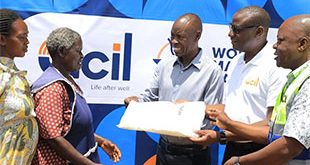
By Agnes E. Nantaba
Godfrey Turyahikayo is the executive director of the Rural Electrification Agency (REA). He spoke to Agnes E. Nantaba about their operations and other pertinent issues in the electricity sector.
What are the key elements in your management style as a manager?
Most important of all is that I am objective oriented. As an institution that is mandated to provide access to electricity to the bulk of the population and the fact that we have set a target for 2040, we must set goals and achieve them. I also work towards motivating the team because for a job that requires a lot of commitment, the leader must motivate the team to undertake the mandate. This helps to keep a steady flow of the workforce so that the institution a low rate of human resource turnover. Indeed, we have one of the lowest among all institutions in the country.
Building the quality of expertise through capacity building so that the employees understand their professional obligations is also vital. To ensure that, we have a comprehensive training programme for members of staff to update their knowledge and refresh their skills. I also believe in mentoring and staff development as a good succession policy to institute good transition and handle work effectively. I prefer delegating responsibility to respective personnel for managing the docket. We set goals on a yearly basis and measurement is done per department but in the interim when the team has issues, they can always consult with me for help.
What is your assessment of the electricity subsector in Uganda?
We are on the right path now. I can say that in the past, we had problems largely due to shortage of resources to develop the necessary infrastructure for providing adequate electricity and grow generation, which led us into big deficits. It is also unfortunate that we had water resources with no funds to develop power generation. For the last 20 years, we were still trying to find out how to get things on course and so we opted for private power generation, which has been affecting the economy negatively, but we have learnt from it.
From the Bujagali Power Dam, we have learnt that projects can be handled from government intervention, which is the reason Isimba Dam and Karuma Dam are on the right track. We have plans for small hydro power projects. So if we continue with the trend, we won’t have shortages of power anymore. Over time, we have appreciated that the power sector is key in economic development so we have to put in place the infrastructure for people to use modern energy, which in turn improves the social and economic stand of the country. That is why we have been moving fast to extend the national grid to as far as possible. The systems we have put in place make it easy to connect more people without an initial requirement of too much upfront financing, which makes the sector promising.
What initiatives has REA undertaken to increase power generation in the country?
One of the key initiatives that we have undertaken is to connect district headquarters covering the entire country. As of now we are doing the last mile in reaching out to these. We shall have covered all 112 districts by end of this financial year. Currently we are standing at about 107 district headquarters. For Buvuma Islands [on Lake Victoria], we are at the feasibility stage to see if the connection can go across the lake. We ensure that we energize all important load centers. We also look at extending power to big centers with cross-economic activity in the different districts. For instance in the [milk producing] Ankole region, we are doing electrification so that the community can earn more from their milk through processing. We are also doing a lot of CSR for areas that are far from the grid through providing solar systems to schools and health centers. We have also realized that if we are to put up the infrastructure that requires high upfront costs, we have to provide subsidies through the output-based aid so that we connect the people at a very nominal cost through a subsidization arrangement after which the individual only pays for consumption.
This was meant to reach critical mass consumers as well as people who are hanging around the transformer but are not connected. We are working on creating a revolving fund that provides for connecting people after which payment is done in installments over a period of time. The increment in payment is so small that it may not be felt but they have to pay back so that we can connect more people. Thus we can have a network of people connected as it is more beneficial to the economy.
Your target was to achieve 10% electricity access for rural Uganda by 2012 but the programme is still stuck at 8.9%. What is the problem?
The assumption of 10% was made with the thinking that people have money to connect but it was later found out that it was unrealistic. Many people out there could not afford to connect themselves to electricity. That is why we put in place subsidies to connect more people. For instance when we put up the lines and transformers, our plan was at least 50%, but the actual connections were approximately 10% due to the high upfront costs.
How then do you intend to spur growth and hit the medium term goal of 26% rural electrification by 2022?
With the current momentum, we are likely to exceed the target and achieve between 30% – 40% by 2022. We are using subsidies for the start in addition to the revolving fund to allow companies like Umeme and other operators to connect people. In this way, every time the meter is charged, there is a markup that is paid back by the consumer so that the money is recovered to connect more people. Once we have consumers that are mapped in, as long as they have wired the house, they get connected.
What are the challenges of transforming the rural population from the use of traditional energy sources to modern energy services?
Some people are not cooperative in terms of allowing lines to pass through their land or getting way-leaves. The other challenge is information. In some instances, we connect people to the grid but some don’t use it for transformation as their expectations are different. Some attach it to lighting only. While there may be social transformation, we want to get to economic transformation where everyone can use electricity to better their lives through economic value. For those who have good ideas and have no capital to start, we have a programme to set up a seed fund that intends to help people buy equipment. That is intended for people to use the energy for economic activities so that we not only fund access to power but also life transformation. When the business starts making returns, the individual can payback so that other people can also benefit from it.
There have been complaints about delays in completion of REA projects, which frustrates economic development. What is your strategy to deliver timely projects?
Up to 95% of the projects are handled by REA. We only experience delays with other parties. Most times the finances from Ministry of Finance are not only released late but are also not enough, which eventually leads to delays. The other delays are experienced with donor-funded projects where there are lots of processes involved and the fact that some don’t send money directly to our accounts thus making the processing to take more time. However, for the case of donor-funded projects, we have agreed with the financiers where there is a standing agreement on funding, to start conducting studies and designs such that after signing the agreement, we get straight to the work on ground. The critical element is to have a good understanding with the Government as an assurance of funding from the donors. With this new arrangement, we are likely to see projects implemented much faster.
How far have you gone with the implementation of phase III of the Rural Electrification Programme of the World Bank?
The agreement was approved by the World Bank and we are in the process of signing. The studies for the projects have all been approved by Parliament. The first phase of the programme has different projects, which will start implementation by the beginning of next year as we are now in the procurement phase for contractors. We have about 23 different projects with which we look at connecting anywhere between 120,000 to 150,000 consumers per year. We are looking at doing more with solar energy.
How does the newly launched community mobilization to connect rural households programme work?
We have teams that go out wherever we have projects to hold meetings with the leadership of the community to show them how they can benefit from the projects. We have two types of connections; one for households which is fully wired, the other is to households with problems with wiring for instance houses without timber. We use a red bolt as a mechanism for connecting them. Through this programme, we sensitize the communities on why we want to get them connected and how it will be done as well as letting them know of their obligations.
Going forward, where do you see rural electrification in Uganda in the next few years?
Considering the next ten years, we hope to have done more than 90% coverage on extending the grid with more than 40% of Ugandans consuming electricity in rural areas going by the current momentum of the strategies in place.
 The Independent Uganda: You get the Truth we Pay the Price
The Independent Uganda: You get the Truth we Pay the Price



